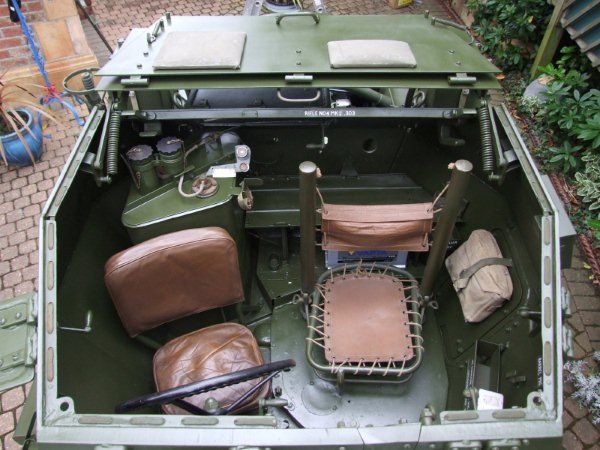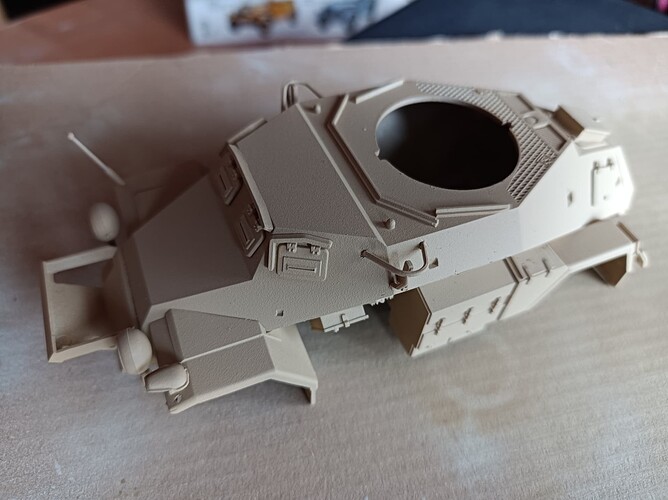The Patton museum had a 223 and the inside was completely painted white-museum pices are usually not good to go by.
I like her. The halftrack was nice too.
I found another reference to the vehicle that Sofilein and Hilary were going over in that video (and the linked one where they’re going around the outside), and it was apparently repainted grey all over prior to a restoration where it was painted dunkelgelb inside and out. Because it could be considered as an open-topped vehicle, though, the area directly below the gun shield may have been originally painted in the exterior color, rather than the whole interior being elfenbein except for the driver’s panel and transmission parts.
Yeah real beauty lol
Ho-ly….I always wondered what happened to 7-of-9’s daughter… ![]()
I used to refer to her by a slightly lower number (not the 9 part).
So I have learned much today. She is Sofilein. She’s 28. She’s single. She’s crazy about historic AFVs. And Hilary Doyle got her inside a 223. I’m going to cry now ![]()
Well said…
Why were the steering wheels angled so awkwardly? This seems to be the case on the Sdkfz. 251.
Think of the exterior shape of the vehicle - often angled armoured plate; the post war Brit armoured cars, Ferret and Saladin were similarly angled.
but why not make it more vertical? Wouldn’t this angle make it weird to hold and steer?
It might be weird and difficult to hold and steer but the crews get used to it; vertical armoured plate is not as effective as angled armour which exponentially, is thicker.
I do not know that answer with certainty, but I can take a stab at an explanation.
The Sd.Kfz. 222 and 223 were built on the same chassis as the Kfz. 15 Horch. Going into World War II, the Germans realized they had a looming maintenance problem stemming from lack of standardization. To rectify this issue, they designed three standard chassis–light, medium, and heavy–and attempted to consolidate on those designs. The medium chassis from that program was the basis of the Kfz. 15 Horch, the Sd.Kfz.222 Light Armored Car, and the Sd.Kfz.223 Light Armored Radio Car.
The Kfz. 15 features a traditional driver’s seat and steering wheel. However, the armored bodies for the Sd.Kfz. 222 and Sd.Kfz. 223 armored cars create a very cramped fighting compartment. The space for the driver is particularly cramped. This is also true of the Sd.Kfz. 251 Halftracks.
If the designers had used a traditional driver’s seat and steering wheel in the armored cars, drivers would find it extremely difficult to get into position and even more difficult to get out. I conjecture that the designers knew this, and therefore turned the steering wheel 90 degrees, such that it no longer obstructs the driver’s knees, allowing him to slide out or be pulled out much more quickly. The lack of a true driver’s seat was very probably a design choice driven by the same consideration. In combat, the driver can thus get into and out of position much more easily, saving lives.
It makes sense, when thinking about it like this.
Or the Dingo where the driver is just canted off like 15 or so degrees from the front

I’d forgotten that one - must have been a disorienting nightmare unitl one got used to it.
Incidentally, I put a Ferret Scout Car into a ditch when visiting an RAOC Vehicle Depot during out last term in Junior Leaders - a sort of “Look at the trades available” thing; the JNCO conducting us around wouldn’t believe me when I said I couldn’t drive. “It’s simple”, he said - don’t worry about the steering wheel.
Dear Sgt. Maj,
Nobody was more surprised than I when…
That poor Corporal was probably on extras for a month.
Do you think it needs a second coat or is it fine?
(do not pay attention to all the little imperfections, I’ll sand them down)
Yeah, it looks pretty even. Nice job!
I jsut found this video while looking for a reference for the dials, and I now udnerstand why the wheel is angled that way.
